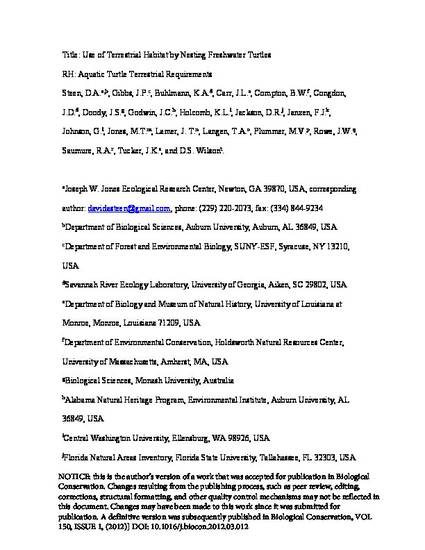
Because particular life history traits affect species vulnerability to development pressures, cross-species summaries of life history traits are useful for generating management guidelines. Conservation of aquatic turtles, many members of which are regionally or globally imperiled, requires knowing the extent of upland habitat used for nesting. Therefore, we compiled distances that nests and gravid females had been observed from wetlands. Based on records of > 8000 nests and gravid female records compiled for 31 species in the United States and Canada, the distances that encompass 95% of nests vary dramatically among genera and populations, from just 8 m forMalaclemys to nearly 1400 m for Trachemys. Widths of core areas to encompass varying fractions of nesting populations (based on mean maxima across all genera) were estimated as: 50% coverage = 93 m, 75% = 154 m, 90% = 198 m, 95% = 232 m, 100% = 942 m. Approximately 6–98 m is required to encompass each consecutive 10% segment of a nesting population up to 90% coverage; thereafter, ca. 424 m is required to encompass the remaining 10%. Many genera require modest terrestrial areas (zones) for 95% nest coverage (Actinemys, Apalone, Chelydra, Chrysemys, Clemmys,Glyptemys, Graptemys, Macrochelys, Malaclemys, Pseudemys, Sternotherus), whereas other genera require larger zones (Deirochelys, Emydoidea, Kinosternon, Trachemys). Our results represent planning targets for conserving sufficient areas of uplands around wetlands to ensure protection of turtle nesting sites, migrating adult female turtles, and dispersing turtle hatchlings.
Available at: http://works.bepress.com/fredric-janzen/52/

NOTICE: this is the author’s version of a work that was accepted for publication in Biological Conservation. Changes resulting from the publishing process, such as peer review, editing, corrections, structural formatting, and other quality control mechanisms may not be reflected in this document. Changes may have been made to this work since it was submitted for publication. A definitive version was subsequently published in Biological Conservation, VOL150, ISSUE 1, June 2012 DOI: 10.1016/j.biocon.2012.03.012